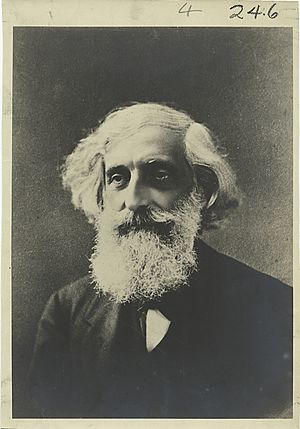William Chauvenet facts for kids
William Chauvenet (born May 24, 1820, died December 13, 1870) was a very important professor. He taught subjects like math, astronomy, and how to navigate ships. He played a huge role in starting the U.S. Naval Academy in Annapolis, Maryland. Later, he became the second leader, or chancellor, of Washington University in St. Louis.
Contents
Growing Up
William Chauvenet was born on a farm close to Milford, Pennsylvania. He grew up in Philadelphia. When he was 16, he started studying at Yale University. He finished his studies in 1840 with great success. While at Yale, William wrote for the school newspaper. He also played the piano for the Beethoven Society. He was one of the first members of a group called the Skull and Bones Society.
In 1841, William Chauvenet became a math professor for the United States Navy. For a while, he taught math on a ship called the USS Mississippi. His time teaching made him see that the U.S. Navy needed its own special school. Other people had thought of this idea before, but no one had made it happen.
In 1842, he became the head of the naval asylum in Philadelphia, Pennsylvania. This place trained future Navy officers. They took an eight-month course before going to sea. William felt this course was not good enough. He created his own plan for a two-year course. He showed his plan to several Navy leaders. Finally, in 1845, his course was accepted.
He was very important in starting the United States Naval Academy in Annapolis, Maryland, in 1845. He taught there for many years. He was also the president of the school's academic board. In 1851, he helped suggest that the course of study should be made longer, to four years. William taught many subjects, including math, surveying, astronomy, and navigation. He also helped build an observatory for studying stars at the academy.
William Chauvenet's work was so important that in 1890, a Navy leader named Admiral S.R. Franklin called him the "Father of the Naval Academy." In 1916, a bronze plaque was put up with this special message.
In 1855, Yale University offered him a job as a math professor. But William said no. He wanted to keep working at the Naval Academy.
Leading Washington University
In 1859, Yale University asked him again. This time, they offered him a job teaching astronomy and natural science. But William chose a different path. He took a job at Washington University in St. Louis. He became a professor of math and astronomy there.
William loved music and classic books. He was also a top scientist. Many historians say he was one of the best math minds in the U.S. before the American Civil War. William used his math skills to check the plans for the first bridge over the Mississippi River in St. Louis. This bridge was designed by James B. Eads.
After his friend Joseph Hoyt died in 1861, the university leaders chose William to be their new chancellor. He took on this leadership role during the Civil War. At that time, the state was divided over the issue of slavery.
Washington University grew a lot while William was chancellor. Many new professors joined, and hundreds more students enrolled. Several new programs were added, including a law school in 1867. William also served as vice president of the United States National Academy of Sciences. He was president of the American Association for the Advancement of Science. He was also a member of two other important groups: the American Philosophical Society and the American Academy of Arts and Sciences.
William Chauvenet wrote many books and textbooks. Some of his famous works include A Manual of Spherical and Practical Astronomy. He also wrote Theory of the Ribbed Arch. His math calculations helped James Buchanan Eads design and build the Eads Bridge in St. Louis.
William Chauvenet was chancellor until he passed away in 1870. William Greenleaf Eliot, who started Washington University, became the next chancellor. William Chauvenet died in St. Paul, Minnesota. He was buried at Bellefontaine Cemetery in St. Louis.
Honored After His Life
After William Chauvenet died, many things were named after him to honor his work:
- The Mathematical Association of America created a special award called the Chauvenet Prize.
- The Naval Academy named a math building after him.
- The U.S. Navy named two ships after him: USS Chauvenet (AGS-11) and Chauvenet (AGS 29).
- A crater on the moon is called Chauvenet.
- A mountain in the Rocky Mountains is named Mount Chauvenet.
See also
 In Spanish: William Chauvenet para niños
In Spanish: William Chauvenet para niños
- Chauvenet's criterion


